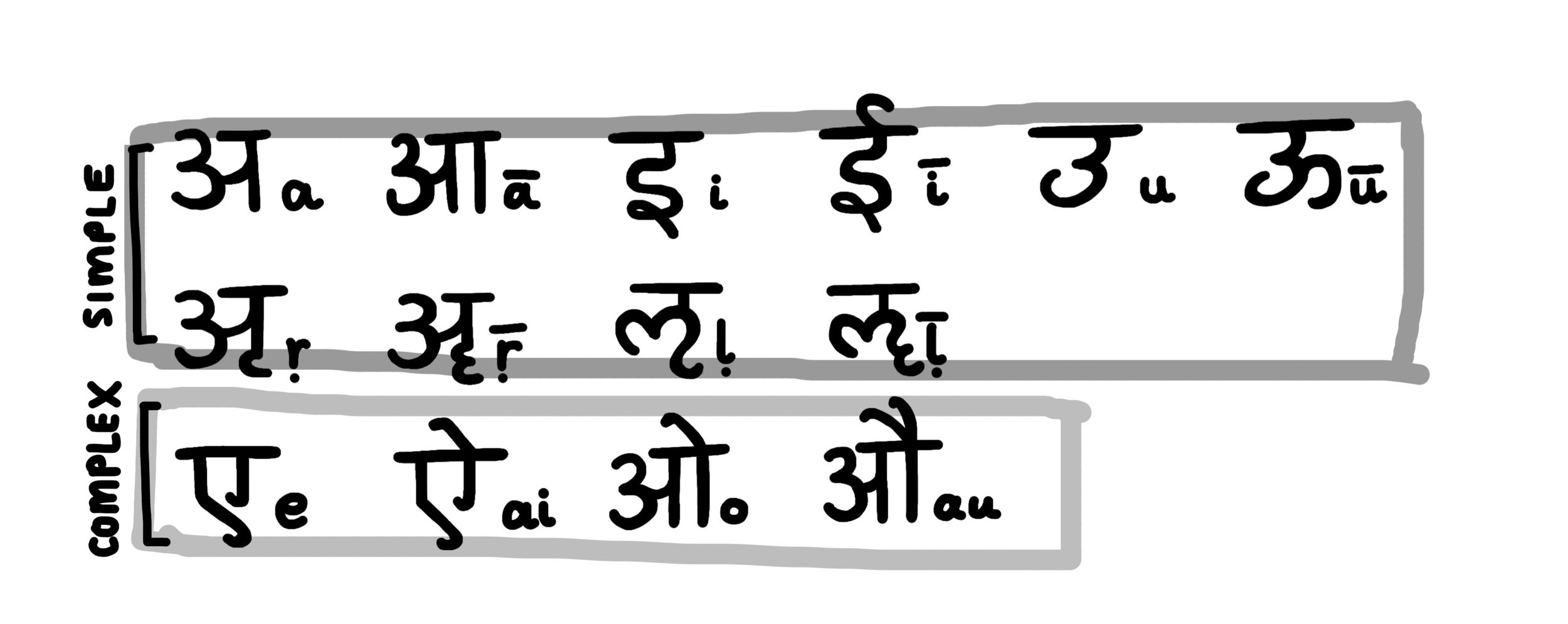[SKT] COMPLEX VOWELS
VOWELS
Vowels are the open-plan office of the vocal tract. They are created by moving air through the oral cavity without obstructing the airflow.
As opposed to consonants, which usually involve some kind of contact or restriction in the mouth-throat area.
Vowels are pronounced by themselves, winning full points for independence and efficiency.
Consonants, on the other hand, are usually pronounced alongside a vowel. For example, if you say the letter m, you actually pronounce it em. Gracious vowel, needy consonant.
In English, we get around with a-e-i-o-u.
In Sanskrit, we have 14 vowels: अ (a) आ (ā) इ (i) ई (ī) उ (u) ऊ (ū) ऋ (r̥) ॠ (r̥̄) ऌ (ḷ) ॡ (ḹ) ए (e) ऐ (ai) ओ (o) औ (au)
In case your browser doesn't render the Devanagari properly:
Fig. 1 Full set of Sanskrit vowels (grey: long-L doesn’t appear anywhere in the language)
Now, five versus 14 seems a bit harsh.
However.
In English, we can pronounce vowels more than one way. For example, the i sound in swift is pronounced quite differently to the i sound in smile.
Although there are only five vowel characters, there are more than five vowel sounds.
In Sanskrit, you get exactly what you sign up for. Each of the 14 vowels are consistently pronounced the same way. 14 characters = 14 sounds.
The long L-vowel (grey in figure 1) appears in the alphabet, but nowhere in the actual language.
So the 14 is kind of 13.
SIMPLE + COMPLEX
Sanskrit vowels can be categorised in a few ways.
First up, we have the division between simple vowels and complex vowels.
Fig. 2 Sanskrit vowels: simple and complex
Simple vowels are the building blocks of vocalic civilisation. A simple vowel has a static pronunciation. The parts of your mouth (mostly the tongue) that get into position to make the sound, stay in the same position for the duration of the vowel.
Whereas a complex vowel is made up of two adjacent simple vowels. When it comes to pronunciation, the place where your speech organs come together can shift between two positions. From the first simple-vowel position through to the second simple-vowel position.
Complex vowels are also known as diphthongs.
An example of a simple vowel sound is a as it's pronounced in calm.
An example of a complex vowel sound is a as it's pronounced in lake. In lake, we have a back-to-back combo of the simple vowel sounds e and i.
Leike.
A simple vowel is like picking a line at the grocery store and not moving even when a different line gets shorter. You are committed to the line and to a pure vowel sound.
The complex vowel moves to another line. It chooses to experience the first and the second line, one after the other. A gliding movement from line "e" to line "i" and you've got yourself a complex vowel sound.
SHORT + LONG
Next we have short vowels and long vowels. This can be summed up by how long the vowel stays in the mouth. The long ones are roughly twice the length of the short.
Fig. 3 Sanskrit vowels: short and long
We do this in English. Compare the a sound in cat (short) to the a sound in late (long). In Sanskrit, these would each get their own character. As mentioned above, all Sanskrit characters have one, consistent, pronunciation. You would never see a long vowel being pronounced as a short vowel. We're not learning a 49-character alphabet for nothing.
VOWEL LENGTH WITHIN COMPLEXITY
Simple vowels have both short and long varieties.
Complex vowels are always long. Remembering that complex vowels are made from two simple vowels, it makes sense that it would take twice as long to pronounce.
COMBINING VOWELS
We're going to circle back to complex vowels and look at why their existence – and behaviour – is important to understand.
Quick recap.
Vowels are things. Sanskrit has heaps of them. Something about groceries. And combining simple vowels creates complex vowels.
But when are vowels getting combined?
All. The. Time.
Because Sanskrit is an inflectional language, it's always declining and conjugating to express itself. It uses endings to show case, number, gender, person, tense etc.
And don't get the 'skrit started on vowel gradation... guna this, guna that.
When creating or deciphering words in Sanskrit, you'll become very familiar with affixes (before = prefix; into = infix; after = suffix). The process of piecing together (or pulling apart) root words and stems and various other endings will involve combining or separating vowels.
BEHAVIOUR
When short vowels are combined, we either get:
- complex vowels, or
- semivowels.
Yes, semivowels. I've been saving that.
If the vowels being combined are followed by a consonant, we get a complex vowel.
If they're followed by another vowel, we get a semivowel. You can either remember this rule or try your best to pronounce three consecutive vowels and realise that's probably not the right answer.
Fig. 4 Combining vowels: creating semivowels and complex vowels
COMPLEX VOWELS IN PREVIOUS TIMES
As you can see in the flow chart (figure 4), the complex vowels used to have different forms. Arguably, more sensible forms than what we use now.
The earlier forms were used ages ago. Possibly even before the language was written with Devanagari. Double-possibly even before Sanskrit was Sanskrit... in whatever language preceded the language that Sanskrit became.
Even though the historic forms aren't used anymore, you can see the original forms still underlie the grammatical patterns that are followed when simple vowels move into complex states. And vice versa.
Every time vowels transfer from simple > complex or complex > simple, they go through the old pattern before getting to their new form.
It's a one-step-back--two-steps-forward kind of thing.







